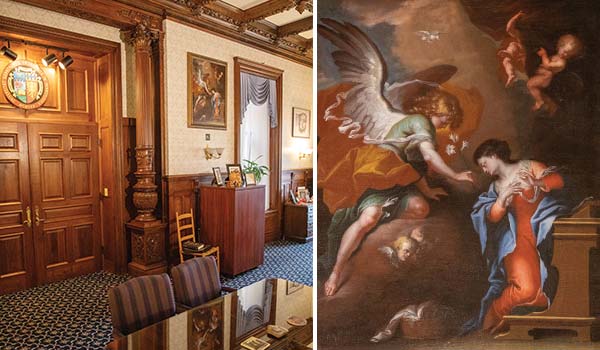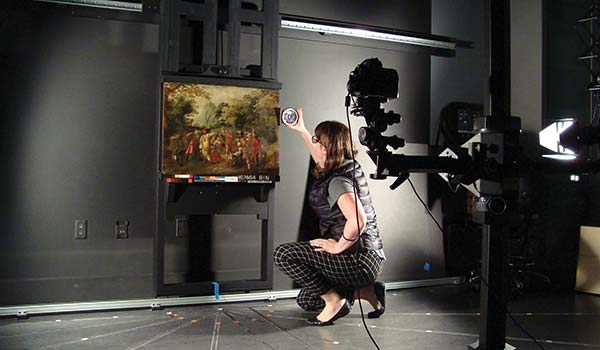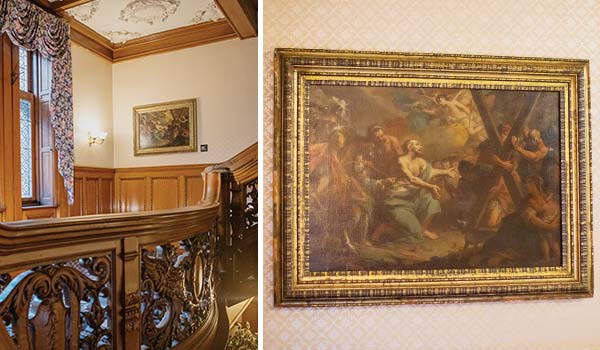Paul Brill’s “Saint John Preaching in the Wilderness,” a more than 350-year-old painting depicting John the Baptist as he promises the coming of the Savior, can be found in Old Main. It is one of 22 Baroque- and Reformation-era paintings that have returned or will return to public view at Gannon after a long absence.
“We call them ‘Found Treasures,’” said Lori Steadman, director of Gannon’s Schuster Gallery.

Paul Brill’s “Annunciation” hangs in the President’s Office in Old Main. (Right) A closeup of the “Annunciation.”
The paintings Steadman is referring to once adorned the walls of Old Main and the former library — what is now Gannon’s Yehl ballroom — in the 1940s through the ’60s. They were relocated to an air handling unit in Gannon’s Nash Library in the 1960s as the campus prepared for the renovation of Old Main and the Waldron Campus Center. The paintings remained undisturbed until Andy Nagle, the maintenance crew leader at Gannon, rediscovered them in 2016.
Now, some of them are being conserved or put back into view as they await restoration. Their journey at Gannon dates back 80 years.
A receipt shows that Archbishop John Mark Gannon purchased the paintings on Oct. 20, 1948 from a New York art dealer named Julius H. Weitzner. The Archbishop bought the paintings for a total of $10,000. A 1949 appraisal valued them at $53,050; their value today has not been calculated.
The religious tone of the paintings offer a clue to their origin.

Jen Munch, a graduate of Buffalo State College, conducts imaging on “Saint John Preaching in the Wilderness” before applying treatment.
“You have to think back in that time. A lot of people didn’t have their own radios, music or art,” Steadman said. “But at church, you’d have beautiful music and beautiful art. Many of these churches sold art so they could help the people during the war.”
The exact origins remain unknown, but the paintings now belong to Gannon as a visual representation and celebration of our Catholic faith, identity and traditions.
“Human thoughts often reveals itself (sic) through an artistic form... There are some states of the soul which can find an expression only through the fine arts. They all have the same source: the instinctive need of human genius to create, to give a real existence to that ideal beauty which seethes within.” - Father A. Crispo, Ph.D., excerpt from “Gannon College Gallery”
Students in the Patricia H. and Richard E. Garman Art Conservation Program at Buffalo State College are helping Gannon conserve the paintings under the supervision of Fiona Beckett, assistant professor of Paintings Conservation at the college. The “Annunciation” and “Saint John Preaching in the Wilderness” have successfully been conserved. Conservation of “Madonna and Child” will begin this fall.
Beckett said the process of restoring the paintings is rigorous and involves analyzing, imaging and documenting the pieces before removing dirt and old varnishes that might otherwise obscure the composition. Structural components such as canvas, wood frames and panels often need to be repaired because they are damaging to the overlying layers of paint. Restoration of a single painting can take up to two years.
As a student, Jen Munch was assigned to “Saint John Preaching in the Wilderness.” She used imaging techniques including infrared light to uncover hidden details of the painting, including a few small figures beneath the upper layers of the painted trees and double profiles of a figure seated on Saint John’s right, suggesting it was reworked a couple of times before the artist was satisfied. Beckett and Munch may be among the first in history to view these historical details.

The “Crucifixion of Saint Andrew” by Guissepe Bazzani is displayed in the staircase in Old Main. (Right) A closeup of the “Crucifixion of Saint Andrew.”
X-ray technology also helped Munch identify a certain pigment, lead-tin yellow, that is associated with the 15th through the 17th centuries, confirming that the painting was created during the time Flemish artist Paul Brill was active.
“Discovering these secrets is always a bonus and really makes these projects worthwhile, both historically and for the conservator conducting the work,” Beckett said.
M.C. Gensheimer, assistant professor and co-director of the School of Communication and the Arts at Gannon, said she hopes to see the rich history of all 22 paintings conserved and returned to Gannon’s walls.
“There’s something about the in-person experience that helps Gannon students understand and appreciate the visual arts. Liberally-educated students need to see good art, high-quality art in order to develop an appreciation and understanding of it,” Gensheimer said. “(Art) is the essence of what we are.”